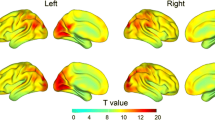In depressed patients, changes in spontaneous brain activity, in particular, the strength of functional connectivity between different regions are observed. The data on changes in the synchrony of different regions of interest in the brain can serve as markers of depressive symptoms and as the targets for the corresponding therapy. The study involved 21 patients with mild depression and 21 healthy volunteers; by the time of second fMRI scanning, 15 and 19 subjects, respectively). The subjects underwent two 4-min sessions of resting state fMRI with 2-4 months interval between the recordings; on the basis of these data, functional connectivity between regions of interest was assessed. During the first session, depressed patients demonstrated more pronounced connection between the right frontal eye field and cerebellar area III. When the sample was restricted to subjects who underwent both fMRI sessions, depressed patients demonstrated closer relations of the right parietal operculum and cerebellar vermis area VIII. During the second recording, healthy subjects showed stronger connectivity between more than 20 frontal, temporal, and subcortical regions of interest and cerebellum area II. In healthy participants, brainstem functional interactions increased from the first to the second fMRI-recording. In depressed subjects a number of cortical areas split from left intraparietal sulcus, but the left temporal cortex became more intra-connected. The results confirm the differences in functional connectivity between depressed and healthy subjects. At the same time, attention should be paid to the variability of the data obtained.
Similar content being viewed by others
References
Mel’nikov ME, Bezmaternykh DD, Petrovskii ED, Kozlova LI, Shtark MB, Savelov AA, Shubina OS, Natarova KA. Peculiarities in Interaction of Independent Components of Resting-State fMRI Signal in Patients with Mild Depressions. Bull. Exp. Biol. Med. 2017;163(4):497-499.
Melnikov MYe, Bezmaternikh DD, Shubina OS, Shtark MB. Resting State fMRI Studies in Depressive Disorders. Uspekhi Fiziol. Nauk. 2017;48(2):30-42. Russian.
Behzadi Y, Restom K, Liau J, Liu TT. A component based noise correction method (CompCor) for BOLD and perfusion based fMRI. Neuroimage. 2007;37(1):90-101.
Besteher B, Gaser C, Langbein K, Dietzek M, Sauer H, Nenadić I. Effects of subclinical depression, anxiety and somatization on brain structure in healthy subjects. J. Affect. Disord. 2017;215:111-117.
Crowther A, Smoski MJ, Minkel J, Moore T, Gibbs D, Petty C, Bizzell J, Schiller CE, Sideris J, Carl H, Dichter GS. Resting-state connectivity predictors of response to psychotherapy in major depressive disorder. Neuropsychopharmacology. 2015; 40(7):1659-1673.
Hwang JW, Xin SC, Ou YM, Zhang WY, Liang YL, Chen J, Yang XQ, Chen XY, Guo TW, Yang XJ, Ma WH, Li J, Zhao BC, Tu Y, Kong J. Enhanced default mode network connectivity with ventral striatum in subthreshold depression individuals. J. Psychiatr. Res. 2016;76:111-120.
Konarski JZ, McIntyre RS, Grupp LA, Kennedy SH. Is the cerebellum relevant in the circuitry of neuropsychiatric disorders? J. Psychiatry and Neurosci. 2005;30(3):178-186.
Linden DE. Neurofeedback and networks of depression. Dialogues Clin. Neurosci. 2014;16(1):103-112.
Philippi CL, Motzkin JC, Pujara MS, Koenigs M. Subclinical depression severity is associated with distinct patterns of functional connectivity for subregions of anterior cingulate cortex. J. Psychiatr. Res. 2015;71:103-111.
Phillips JR, Hewedi DH, Eissa AM, Moustafa AA. The cerebellum and psychiatric disorders. Front. Public Health. 2015;3:66. doi: https://doi.org/10.3389/fpubh.2015.00066.
van Wingen GA, Tendolkar I, Urner M, van Marle HJ, Denys D, Verkes RJ, Fernández G. Short-term antidepressant administration reduces default mode and task-positive network connectivity in healthy individuals during rest. Neuroimage. 2014;88:47-53.
Wang J, Wei Q, Yuan X, Jiang X, Xu J, Zhou X, Tian Y, Wang K. Local functional connectivity density is closely associated with the response of electroconvulsive therapy in major depressive disorder. J. Affect. Disord. 2018;225:658-664.
Xia M, Wang J, He Y. BrainNet Viewer: a network visualization tool for human brain connectomics. PLoS One. 2013;8(7):e68910. doi: https://doi.org/10.1371/journal.pone.0068910.
Yang Z, Wang H, Zhang Z, Zhong Y, Chen Z, Lu G. Study based on ICA of “dorsal attention network” in patients with temporal lobe epilepsy. Sheng Wu Yi Xue Gong Cheng Xue Za Zhi. 2010;27(1):10-15.
Author information
Authors and Affiliations
Corresponding author
Additional information
Translated from Byulleten’ Eksperimental’noi Biologii i Meditsiny, Vol. 165, No. 6, pp. 690-697, June, 2018
Rights and permissions
About this article
Cite this article
Bezmaternykh, D.D., Mel’nikov, M.E., Kozlova, L.I. et al. Functional Connectivity of Brain Regions According to Resting State fMRI: Differences between Healthy and Depressed Subjects and Variability of the Results. Bull Exp Biol Med 165, 734–740 (2018). https://doi.org/10.1007/s10517-018-4254-z
Received:
Published:
Issue Date:
DOI: https://doi.org/10.1007/s10517-018-4254-z



